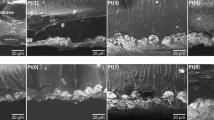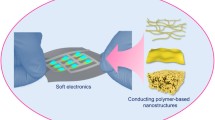Abstract
Conducting polymer nanostructures such as nanofibers and nanotubes have potential uses in a variety of applications including electronic and photonic devices and sensors. Conducting polymers have also been used as artificial muscles. In this work, template synthesis method for fabricating solid polypyrrole nanowires and polypyrrole-gold nanowire heterostructures is demonstrated to explore suitability of these structures as nano-artificial muscles or nanoactuators. Polypyrrole nanowires are evaluated in an aqueous electrolyte to see if they retain the ability to expand and contract under electrochemical cycling. Template synthesis is then used to alternatively electroplate gold and electropolymerize polypyrrole in the pores of an alumina membrane to create layered polypyrrole-gold nanowires.
Similar content being viewed by others
References
C. R. Martin, R. Parthasarathy, and V. Menon, “Template Synthesis of Electronically Conductive Polymers – a New Route for Achieving Higher Electronic Conductivities,” Synthetic Metals, 55–57, 1165–1170, 1993.
C. R. Martin, “Template Synthesis of Electronically Conductive Polymer Nanostructures,” Acc. Chem. Res., 28, 61–68, 1995.
C. Schönenberger, B. M. I. van der Zande, L. G. J. Fokkink, M. Henny, C. Schmid, M. Krüger, A. Bachtold, R. Huber, H. Birk, and U. Staufer, “Template Synthesis of Nanowires in Porous Polycarbonate Membranes: Electrochemistry and Morphology,” J. Phys. Chem. B, 101, 5497–5505, 1997.
S. Demoustier-Champagne and P. Stavaux, “Effect of Electrolyte Concentration and Nature on the Morphology and the Electrical Properties of Electropolymerized Polypyrrole Nanotubules,” Chem. Mater., 11, 829–834, 1999.
M. Lu, X. Li, H. Li, “Synthesis and characterization of conducting copolymer nanofibrils of pyrrole and 3-methilthiophene using the template-synthesis method, Materials Science and Engineering, A334, 291–297, 2002.
J. Joo et al., “Conducting Polymer Nanotube and Nanowire Synthesized by Using Nanoporous Template: Synthesis, Characteristics, and Applications,” Synthetic Metals, 135–136, 7–9, 2003.
T. F. Otero and J. M. Sansiñena, “Artificial muscles based on conducting polymers,” Bioelectrochem. Bioen., 38, 411, 1995.
R. H. Baughman, “Conducting polymer artificial muscles,” Synthetic Metals, 78, 339–353, 1996.
Y. Berdichevsky and Y.-H. Lo, “Fabrication of polypyrrole nanowires,” Proc. Of SPIE: Smart Structures and Materials 2005: Electroactive Polymer Actuators and Devices (EAPAD), 5759, 2005.
Q. Pei and O. Inganäs, “Electrochemical Applications of the Bending Beam Method. 2. Electroshrinking and Slow Relaxation in Polypyrrole,” J. Phys. Chem., 97, 6034–6041, 1193.
E. Smela, “Microfabrication of PPy microactuators and other conjugated polymer devices,” J. Micromech. Microeng., 9, 1–18, 1999.
Author information
Authors and Affiliations
Rights and permissions
About this article
Cite this article
Berdichevsky, Y., Lo, YH. Fabrication and Evaluation of Conducting Polymer Nanowire Heterostructures. MRS Online Proceedings Library 872, 134 (2005). https://doi.org/10.1557/PROC-872-J13.4
Published:
DOI: https://doi.org/10.1557/PROC-872-J13.4




